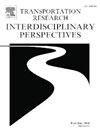Acceptance towards automated vehicles in urban traffic: A survey of pedestrian’s attitudes and behavioral intentions
IF 3.9
Q2 TRANSPORTATION
Transportation Research Interdisciplinary Perspectives
Pub Date : 2025-04-16
DOI:10.1016/j.trip.2025.101416
引用次数: 0
Abstract
Acceptance is vital for the successful integration of automated vehicles (AVs) into urban traffic. This is not only true for potential users of such vehicles. Other road users’ perceptions and actions are just as important when designing AVs. Previous research has primarily focused on pedestrians’ direct interactions with AVs (e.g., willingness to cross). However, there are other ways in which pedestrians might react to the presence of AVs. In the worst case, they avoid participating in urban traffic or obstruct AVs. To address this issue, this study surveyed N = 1,995 residents of Munich, Germany, to assess their perceptions of the potential integration of AVs and their expected behavior in urban traffic. The survey was structured around four dimensions: direct interactions with AVs (Pedestrian-AV Interaction), perceptions of the general future behavior of AVs towards pedestrians (Traffic Climate), the broader impact on urban traffic (Societal Factors) and Demographic and Individual Factors. Acceptance was measured by general attitudes toward AVs in urban traffic and their intention to cross, avoid and sabotage AVs. The results showed that attitudes and behavioral intentions could be accurately predicted across these four dimensions, except for sabotage intentions. Expectations regarding direct interactions with AVs emerged as the most important aspect, although perceptions of the general future behavior of AVs and broader impacts on urban traffic also influenced behavioral intentions and attitudes. The findings underscore the importance of exploring pedestrian acceptance beyond mere willingness to cross to ensure a comprehensive understanding of pedestrian attitudes toward AVs in urban traffic.
城市交通中对自动驾驶汽车的接受程度:行人态度和行为意向调查
接受度对于自动驾驶汽车(AVs)成功融入城市交通至关重要。这不仅适用于此类车辆的潜在用户。在设计自动驾驶汽车时,其他道路使用者的感知和行为也同样重要。之前的研究主要集中在行人与自动驾驶汽车的直接互动上(例如,是否愿意过马路)。然而,行人可能会以其他方式对自动驾驶汽车的存在做出反应。在最坏的情况下,他们会避免参与城市交通或阻碍自动驾驶汽车。为了解决这一问题,本研究调查了德国慕尼黑的N = 1995名居民,以评估他们对自动驾驶汽车潜在整合的看法以及他们在城市交通中的预期行为。该调查围绕四个维度进行:与自动驾驶汽车的直接互动(行人与自动驾驶汽车的互动),对自动驾驶汽车对行人的总体未来行为的看法(交通气候),对城市交通的更广泛影响(社会因素)以及人口和个人因素。通过对城市交通中自动驾驶汽车的总体态度以及他们穿越、避开和破坏自动驾驶汽车的意图来衡量接受度。结果表明,态度和行为意图在这四个维度上都可以被准确预测,但破坏意图除外。对与自动驾驶汽车直接互动的期望成为最重要的方面,尽管对自动驾驶汽车总体未来行为的看法以及对城市交通的更广泛影响也影响了行为意图和态度。研究结果强调了探索行人接受度的重要性,而不仅仅是愿意过马路,以确保全面了解行人对城市交通中自动驾驶汽车的态度。
本文章由计算机程序翻译,如有差异,请以英文原文为准。
求助全文
约1分钟内获得全文
求助全文
来源期刊

Transportation Research Interdisciplinary Perspectives
Engineering-Automotive Engineering
CiteScore
12.90
自引率
0.00%
发文量
185
审稿时长
22 weeks
 求助内容:
求助内容: 应助结果提醒方式:
应助结果提醒方式:


